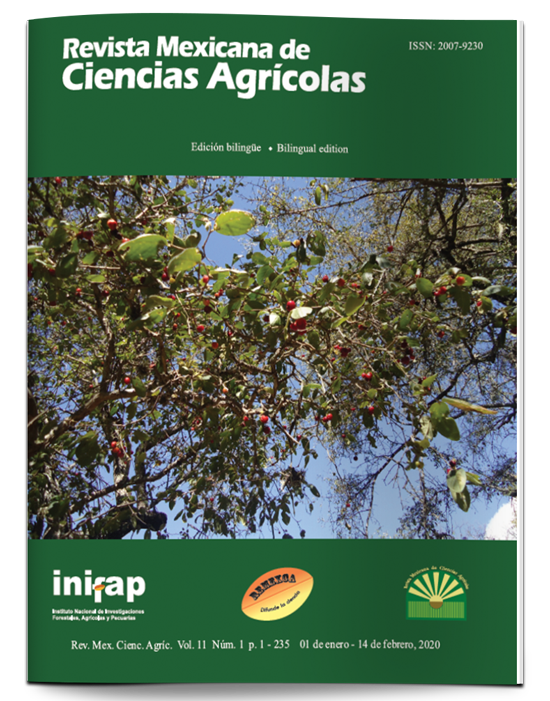Pumpkin curly leaf virus (SLCV): diagnosis, population dynamics of the vector and spatio-temporal distribution of the virus
DOI:
https://doi.org/10.29312/remexca.v11i1.1754Keywords:
Bemisia tabaci, Cucurbita pepo, Geminivirus, severityAbstract
The members of the genus begomovirus are transmitted by Bemisia tabaci and cause severe losses in cucurbitaceae. The objectives of the study were: i) to investigate the etiology of the disease caused by the pumpkin leaf curly virus; ii) know the population dynamics of the vector, compare the effectiveness of yellow sticky traps against yellow trays and determine the effect of the location of the traps, in monitoring B. tabaci during the crop development cycle; and iii) study the spatio-temporal distribution and severity of pumpkin virosis. The study was carried out in the experimental station of the Superior Agricultural College of the State of Guerrero, located in the Cocula Valley, Guerrero, Mexico. DNA was extracted from pumpkin leaves (Cucurbita pepo) var. Gray Zucchini with symptoms of virosis. The PCR was carried out in five samples with the generic oligonucleotides for begomoviruses, two PCR products were sequenced and a phylogenetic tree was generated. Pumpkin virus transmission test was performed, under controlled conditions. The population dynamics of B. tabaci was determined using sticky yellow traps and yellow trays. From the symptomatology, the severity percentage and the area under the disease progress curve (ABCPE) were obtained. PCR analysis, sequencing and phylogeny, confirmed the presence of the SLCV virus (KX620945.1-DAAV-1) in pumpkin. It was found that B. tabaci transmits to SLCV that significantly reduces plant growth. The sticky trap and sampling date influence the population fluctuation of B. tabaci. The incidence of B. tabaci and severity of SLCV were manifested in all the phenological stages of the crop and related to the temperature level.
Downloads
Published
How to Cite
Issue
Section
License
The authors who publish in Revista Mexicana de Ciencias Agrícolas accept the following conditions:
In accordance with copyright laws, Revista Mexicana de Ciencias Agrícolas recognizes and respects the authors’ moral right and ownership of property rights which will be transferred to the journal for dissemination in open access. Invariably, all the authors have to sign a letter of transfer of property rights and of originality of the article to Instituto Nacional de Investigaciones Forestales, Agrícolas y Pecuarias (INIFAP) [National Institute of Forestry, Agricultural and Livestock Research]. The author(s) must pay a fee for the reception of articles before proceeding to editorial review.
All the texts published by Revista Mexicana de Ciencias Agrícolas —with no exception— are distributed under a Creative Commons License Attribution-NonCommercial 4.0 International (CC BY-NC 4.0), which allows third parties to use the publication as long as the work’s authorship and its first publication in this journal are mentioned.
The author(s) can enter into independent and additional contractual agreements for the nonexclusive distribution of the version of the article published in Revista Mexicana de Ciencias Agrícolas (for example include it into an institutional repository or publish it in a book) as long as it is clearly and explicitly indicated that the work was published for the first time in Revista Mexicana de Ciencias Agrícolas.
For all the above, the authors shall send the Letter-transfer of Property Rights for the first publication duly filled in and signed by the author(s). This form must be sent as a PDF file to: revista_atm@yahoo.com.mx; cienciasagricola@inifap.gob.mx; remexca2017@gmail.
This work is licensed under a Creative Commons Attribution-Noncommercial 4.0 International license.



